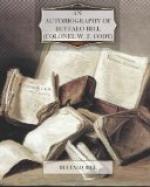The first of these came suddenly. We were strung out over the trail near the Platte, about twenty miles from the scene of the Indian attack on McCarthy’s outfit, watching the buffalo scattered to right and left of us, when we heard two or three shots, fired in rapid succession.
Before we could find out who fired them, down upon us came a herd of buffalo, charging in a furious stampede. There was no time to do anything but jump behind our wagons. The light mess-wagon was drawn by six yoke of Texas steers which instantly became part of the stampede, tearing away over the prairie with the buffalo, our wagon following along behind. The other wagons were too heavy for the steers to gallop away with; otherwise the whole outfit would have gone.
I remember that one big bull came galloping down between two yoke of oxen, tearing away the gooseneck and the heavy chain with each lowered horn. I can still see him as he rushed away with these remarkable decorations dangling from either side. Whether or not his new ornaments excited the admiration of his fellows when the herd came to a stand later in the day, I can only guess.
The descent of the buffalo upon us lasted only a few minutes, but so much damage was done that three days were required to repair it before we could move on. We managed to secure our mess-wagon, again, which was lucky, for it contained all our provender.
We learned afterward that the stampede had been caused by a returning party of California gold-seekers, whose shots into the herd had been our first warning of what was coming. Twice before we neared the Mormon country we were attacked by Indians. The army was so far ahead that they had become bold. We beat off the attacks, but lost two men.
It was white men, however, not Indians, who were to prove our most dangerous enemies. Arriving near Green River we were nooning on a ridge about a mile and a half from a little creek, Halm’s Fork, where the stock were driven to water. This was a hundred and fifteen miles east of Salt Lake City, and well within the limits of the Mormon country.
Most of the outfit had driven the cattle to the creek, a mile and a half distant, and were returning slowly, while the animals grazed along the way back to camp. I was with them. We were out of sight of the wagons.
As we rose the hill a big bearded man, mounted and surrounded by a party of armed followers, rode up to our wagon-master.
“Throw up your hands, Simpson!” said the leader, who knew Simpson’s name and his position.
Simpson was a brave man, but the strangers had the drop and up went his hands. At the same time we saw that the wagons were surrounded by several hundred men, all mounted and armed, and the teamsters all rounded up in a bunch. We knew that we had fallen into the hands of the Mormon Danites, or Destroying Angels, the ruffians who perpetrated the dreadful Mountain Meadows Massacre of the same year. The leader was Lot Smith, one of the bravest and most determined of the whole crowd.




